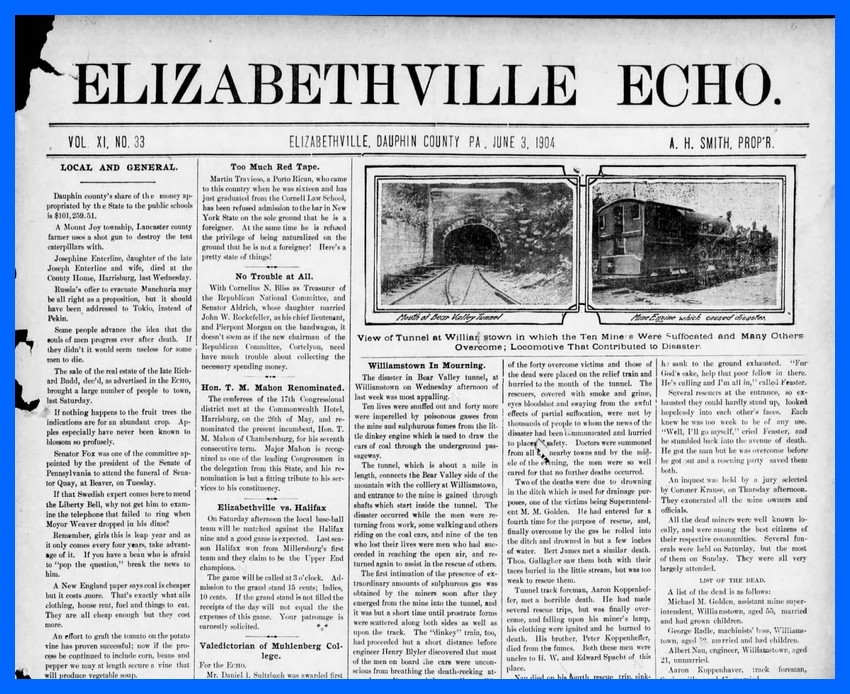The front page of the Elizabethville Echo of 3 June 1904 carried the following report on the Great Mine Disaster at Williamstown, Dauphin County, Pennsylvania:
Williamstown in Mourning
The disaster in Bear Valley Tunnel, at Williamstown, on Wednesday afternoon of last week was most appalling.
Ten lives were snuffed out and forty more were imperiled by poisonous gases from the mine and sulfurous fumes from the little dinkey engine which is used to draw the cars of coal through the underground passageway.
The tunnel, which is about a mile in length, connects the Bear Valley side of the mountain with the colliery at Williamstown, and entrance to the mine is gained through shafts which start inside the tunnel. The disaster occurred while the men were returning from work, some walking and others riding in the coal cars, and nine of the ten who lost their lives were men who had succeeded in reaching the open air, and returned again to assist in the rescue of others.
The first intimation of the presence of extraordinary amounts of sulfurous gas was obtained by the miners soon after they emerged from the mine into the tunnel , and it was but a short time until prostrate forms were scattered along both sides as well as upon the track. The “dinkey” train, too, had proceeded but a short distance before engineer Henry Blyler discovered that most of the men on board the cars were unconscious from breathing the death-reeking atmosphere. He crowded on all possible steam, and hurried toward the Williamstown end of the tunnel, but in a short time he was overcome and losing his grip on the throttle rolled from his seat. His place was quickly taken over by another and the journey continued. It was thought for a time that Blyler would died, but shortly after reaching the outside, he recovered.
Th work of rescue was hazardous, and the scenes, as the dead and dying were brought to the outside were most pathetic.
in spite of the immense odds against which the rescuing party worked, the bodies of the forty overcome victim and those of the dead were placed on the relief train and hurried to the mouth of the tunnel. The rescuers, covered with smoke and grime, eyes bloodshot and swaying from the awful effects of partial suffocation, were met by thousands of people to whom the news of the disaster had been communicated and hurried to places of safety. Doctors were summoned from the nearby towns and by the middle of the evening, the men were so well cared for that no further deaths occurred.,
Two of the deaths were due to drowning in the ditch which is used for drainage purposes, one of the victims being Superintendent M. M. Golden. He had entered for a fourth time for the purpose of rescue, and, finally overcome by the gas he rolled into the ditch and drowned in but a few inches of water. Bet James met a similar death. Thomas Gallagher saw them both with their faces buried in the little stream, but was too weak to rescue them.
Tunnel track foreman, Aaron Koppenhaver, met a horrible death. He had made several rescue trips, but was finally overcome, and falling upon his miners lamp, his clothing were ignited and he burned to death. His brother, Peter Koppenhaver, died from the fumes. Both these men were uncles to H. W. Spacht and Edward Spacht of this place [Elizabethville].
Nau died on his fourth rescue trip, sinking to the ground with a man on his shoulder.
George Radel, John Kinney, Enoch Morgan and Henry Frederick, sick and exhausted, could not endure the thought of turning away from the work of rescue, and they entered the tunnel only to be themselves carried out dead.
The heroic work of George Feaster, is perhaps particularly noteworthy. He had emerged from the death chamber a fourth time, each bringing with him the unconscious form of a fellow workman, when he sank to the ground exhausted. “For God’s sake, help that poor fellow in there. He’s calling and I’m all in,” called Feaster.
Several rescuers at the entrance, so exhausted they could hardly stand up, looked hopelessly into each other’s faces. Each knew he was too weak to be of any use. “Well, I’ll go myself,” cried Feaster, and he stumbled back into the avenue of death. He got the man but he was overcome before he got out and a rescuing party saved them both.
An inquest was held by a jury selected by Coroner Krause, on Thursday afternoon. The exonerated all the mine owners and officials.
All the dead miners were ell known locally, and were among the best citizens of their respective communities. Several funerals were held on Saturday, but the most of them on Sunday. They were all very largely attended.
LIST OF THE DEAD
A list of the dead is as follows:
Michael M. Golden, assistant mine superintendent, Williamstown, aged 55, married and had grown children.
George Radle, machinists’ boss, Williamstown, aged 52, married and had children.
Albert Nau, engineer, Williamstown, aged 21, unmarried.
Aaron Koppenhaver, track foreman, Springville, aged 47, married.
Peter Koppenhaver, miner, Springville, aged 40, married and had family.
Enoch Morgan, miner, Williamstown, aged 38, married and had four children.
Burt James, miner, Williamstown, aged 28, unmarried.
Henry Frederick, laborer for track foreman, Springville, aged 40, married and had children.
John Kinney, miner, Williamstown, aged 30, married and had several children.
Joseph Punch, laborer, Williamstown, aged 24, unmarried.
__________________________________
Corrections and additional information should be added as comments to this post.
Note: The two pictures accompanying the article are featured in separate blog posts. See: Entrance to Bear Mountain Tunnel and Mine Engine Which Caused Disaster.
Newspaper front page and article from Newspapers.com.
